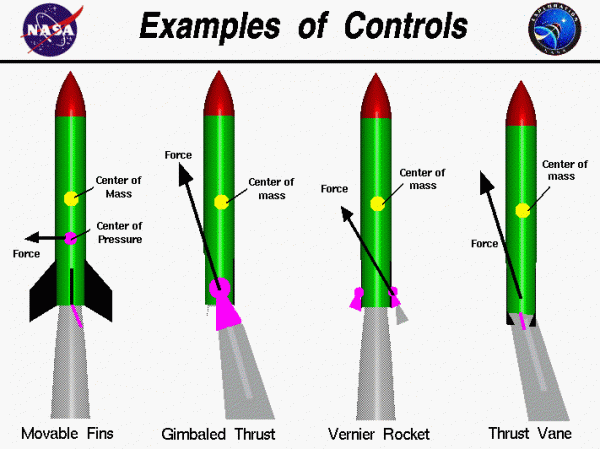Rocket Control

4 Major Components
There are four major components to any full scale rocket; structural system or frame, the payload system, the guidance system, and the propulsion system. The guidance system of a rocket includes very sophisticated sensors, on-board computers, radars, and communication equipment. The guidance system has two main roles during the launch of a rocket; to provide stability for the rocket, and to control the rocket during maneuvers.
Controlling Rockets in Flight
Many different methods have been developed to control rockets in flight. On this slide we look at four of these methods. The motion of any object in flight is a combination of the translation of the center of gravity and the rotation of the object about its center of gravity, which is also called the center of mass. All of the control methods produce a torque about the rocket’s center of gravity which causes the rocket to rotate in flight. Through an understanding of the forces acting on the rocket and the resulting motion, the rocket guidance system can be programmed to intercept targets, or to fly into orbit.
Moveable Fins
Early rockets and current air-to-air missiles typically use movable fins at the rear of the rocket. The movable fin adjusts the amount of the aerodynamic force on the rocket. The aerodynamic force acts through the center of pressure which is normally not located at the center of gravity. The difference in location generates the torque about the center of gravity, or center of mass. On the figure, the trailing edge of the fin facing us has been colored magenta and has been deflected to the right. The resulting aerodynamic force would move the nose of the rocket to the right.
Control Torque
Most modern rockets rotate, or gimbal, the nozzle to produce the control torque. In a gimbaled thrust system, the exhaust nozzle of the rocket can be swiveled from side to side. As the nozzle is moved, the direction of the thrust is changed relative to the center of gravity of the rocket. On the figure the rocket nozzle is colored magenta and has been pivoted to the right. The resulting thrust force would move the nose of the rocket to the right.
Older Rockets
Some older rockets, like the Atlas missile, used small additional rocket engines at the bottom of the main rocket to generate the control torque. The small control rockets were called vernier rockets. In the figure, the right vernier rocket engine is colored magenta and has been fired to cause the nose of the larger rocket to move to the right. Because of the additional weight for the fuel and plumbing, vernier rockets are not used much any more.
Early Rockets
On some early rockets, like the V2 and Redstone rocket, small thrust vanes were placed in the exhaust stream of the main rocket to deflect the thrust and produce a control torque. In the figure, a thrust vane has been colored magenta and is deflected to the right. This causes the exhaust stream to be deflected and the nose of the rocket would move the right.
